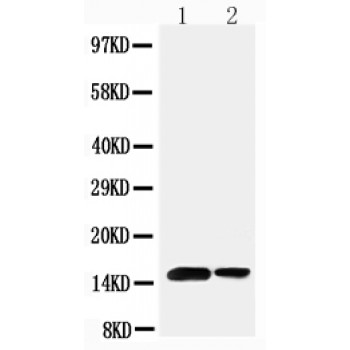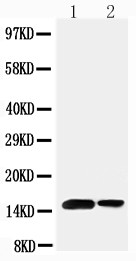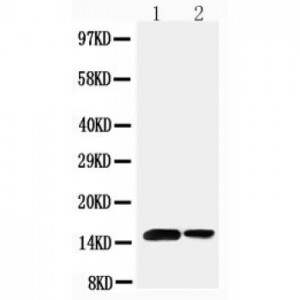More info
Overview
Long Name | Antibody Type | Antibody Isotype | Host | Species Reactivity | Validated Applications | Purification |
| small ubiquitin-like modifier 1 | Polyclonal | IgG | Rabbit | Human, Mouse, Rat | WB | Immunogen affinity purified. |
Immunogen | ||||||
| A synthetic peptide corresponding to a sequence at the N-terminus of human Sumo 1(15-30aa DKKEGEYIKLKVIGQD), identical to the related mouse and rat sequences. | ||||||
Properties
Form | Lyophilized |
Size | 100 µg/vial |
Contents | Antibody is lyophilized with 5 mg BSA, 0.9 mg NaCl, 0.2 mg Na2HPO4, 0.05 mg Thimerosal and 0.05 mg NaN3. *carrier free antibody available upon request. |
Concentration | Reconstitute with 0.2 mL sterile dH2O (500 µg/ml final concentration). |
Storage | At -20 °C for 12 months, as supplied. Store reconstituted antibody at 2-8 °C for one month. For long-term storage, aliquot and store at -20 °C. Avoid repeated freezing and thawing. |
Additional Information Regarding the Antigen
Gene | SUMO1 |
Protein | Small ubiquitin-related modifier 1 |
Uniprot ID | P63165 |
Function | Ubiquitin-like protein that can be covalently attached to proteins as a monomer or a lysine-linked polymer. Covalent attachment via an isopeptide bond to its substrates requires prior activation by the E1 complex SAE1-SAE2 and linkage to the E2 enzyme UBE2I, and can be promoted by E3 ligases such as PIAS1-4, RANBP2 or CBX4. This post-translational modification on lysine residues of proteins plays a crucial role in a number of cellular processes such as nuclear transport, DNA replication and repair, mitosis and signal transduction. Involved for instance in targeting RANGAP1 to the nuclear pore complex protein RANBP2. Covalently attached to the voltage-gated potassium channel KCNB1; this modulates the gating characteristics of KCNB1 (PubMed:19223394). Polymeric SUMO1 chains are also susceptible to polyubiquitination which functions as a signal for proteasomal degradation of modified proteins. May also regulate a network of genes involved in palate development. |
Tissue Specificity | |
Sub-cellular localization | Nucleus membrane. Nucleus speckle. Cytoplasm. Nucleus, PML body. Cell membrane. |
Sequence Similarities | Belongs to the ubiquitin family. SUMO subfamily. |
Aliases | GAP modifying protein 1 antibody|GAP-modifying protein 1 antibody|GMP 1 antibody|GMP1 antibody|OFC10 antibody|PIC 1 antibody|PIC1 antibody|SENP2 antibody|Sentrin 1 antibody|Sentrin antibody|Small ubiquitin related modifier 1 antibody|Small ubiquitin-like modifier 1 antibody|Small ubiquitin-related modifier 1 antibody|SMT3 antibody|SMT3 homolog 3 antibody|SMT3 suppressor of mif two 3 homolog 1 antibody|SMT3, yeast, homolog 3 antibody|SMT3C antibody|SMT3H3 antibody|SUMO-1 antibody|Sumo1 antibody|SUMO1_HUMAN antibody|Ubiquitin homology domain protein PIC1 antibody|Ubiquitin Like 1 antibody|Ubiquitin like protein SMT3C antibody|Ubiquitin like protein UBL1 antibody|Ubiquitin-homology domain protein PIC1 antibody|Ubiquitin-like protein SMT3C antibody|Ubiquitin-like protein UBL1 antibody|UBL 1 antibody|UBL1 antibody |
Application Details
| Application | Concentration* | Species | Validated Using** |
| Western blot | 0.1-0.5μg/ml | Human, Rat Mouse | AssaySolutio's ECL kit |
AssaySolution recommends Rabbit Chemiluminescent WB Detection Kit (AKIT001B) for Western blot. *Blocking peptide can be purchased at $65. Contact us for more information

Anti-Sumo 1 antibody, ASA-B1810, Western blotting
Lane 1: Rat Spleen Tissue Lysate
Lane 2: Human Placenta Tissue Lysate
Lane 1: Rat Spleen Tissue Lysate
Lane 2: Human Placenta Tissue Lysate



